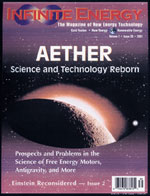![Akronos logo]](/images/akronos_wheel.jpg)
|
Akronos Publishing Concord, ON, Canada www.aetherometry.com |
![Akronos logo]](/images/akronos_wheel.jpg)
|
Akronos Publishing Concord, ON, Canada www.aetherometry.com |

The Sagnac and Michelson-Gale-Pearson experiments:
the tribulations of General Relativity with respect to rotation
by Correa, Paulo N. & Correa, Alexandra N.
Published in April 2002. 41 pages.
Series: Aetherometry Reprints
Monograph AS4-02
VIEW FULL TEXT: PDF
This monograph was first published in Infinite Energy #39.
|
ABSTRACT
In the history and theory of Physics there are accursed experiments voted to systematic oblivion. Two such examples are the 1913 Sagnac and the 1925 Michelson- Gale-Pearson (MGP) experiments, which, to this day, remain welded together as the repressed of General Relativity (GR). That the MGP experiment was voted to oblivion is all the more glaring an omission, since it was supposed to provide a test for Einstein's "principle of equivalence" of inertial and gravitational masses, the actual basis for GR. The relativistic expectation sanctioned by Einstein in 1924, was that the MGP experiment should detect a full fringe shift in order to confirm General Relativity, whereas a null result would have been compatible with the notion of a partial aether drag. Note that the expectations regarding the null result had now been inverted with respect to the MM experiment, because the MGP experiment tested for rotation and not translation of the earth. So argued Einstein. In this context, the authors wonder why should rotation be measurable because of a Space-Time drag of inertial frames in rotation, and translation remain unmeasurable and unable to elicit the dragging of its own inertial frame, when translation is also a gravitational motion and there must be equivalence in principle between inertial and non-inertial frames? The problem is further highlighted by GR's later confrontation in the early 1930's with the 1913 Sagnac effect, because GR is here constrained to admit that, 'for non-inertial frames', the speed of light is no longer constant. After all, to be consistent with itself, as Aspden has pointed out, Relativity should have followed Mach's lead and proposed that one should not be able to electromagnetically measure any speed of rotation with respect to Space. To achieve this somersault, Einstein adopted the relativistic dragging of inertial frames from aether drag theory, and even went as far as claiming in 1920 that with GR, "the conception of the ether has again acquired an intelligible content, although this content differs widely from that of the ether of the mechanical undulatory theory of light". But did Einstein's trajectory remain loyal to this program? The authors contend that it did not. Central to the GR paradox was the axiomatic assumption that gravitational field energy can be treated as reducible to the interval metric structure of Space-Time itself. From an energeticist perspective, this was an essential metaphysical lapse - emptying gravitation of its energetic content and replacing it with the structure of a manifold that is susceptible to the criticism that it essentially confuses Time with Space. Moreover, there is no intrinsic or heuristic requirement on the part of the Sagnac effect for any time-dilation transformations. Einstein was in fact obliged to treat the continuum as a pseudo-Riemannian manifold that had a separate physical reality distinct from the spatiotemporal relations between material objects. This clearly introduced substantivist considerations into what was originally deemed to be a relationist project. These considerations lead one to become suspicious of Einstein's utterances about an aether compatible with Relativity. The problem is that the 'aether' that Einstein increasingly appeared to have in mind, rather than becoming, as promised, a 'non-material, non-mechanical and gravitational aether', turned instead into a pure metaphysical fiction; a disembodied Spatial reality endowed solely with a mathematical existence and barred from any access to Time and synchronicity. Einstein operated a reduction of gravitational theory to geometry, and ultimately precluded therefore any recourse to the notion of gravitational energy. With this mystification, rotation was indeed made to appear as a mystery of nature. Subsequent evolution of relativistic cosmology at the hands of Einstein's successors has resurrected the problem of absolute motion in the measurement of peculiar velocity with respect to the CBR. A cosmic universal frame of reference for the propagation of electromagnetic energy has been found, in direct contravention of Special Relativity - yet, as soon as it was made, this discovery was co-opted by Big- Bang ideologists as evidence for a cosmic entropy. Relativist metaphysics succeeded in keeping its cake and eating it too. Such are the privileges of theories that become part of the organon of royal science. |